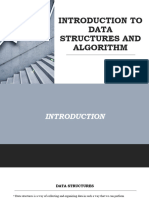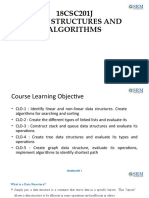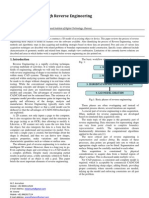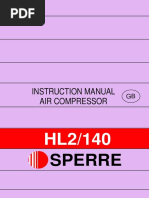Intro To Data Structures and Algorithms
Uploaded by
Tony StarkIntro To Data Structures and Algorithms
Uploaded by
Tony StarkData Structures and
Data Structures and
Algorithms
Algorithms
Luciano Bononi
Computer Science Engineering
University of Bologna
bononi@cs.unibo.it
http!!""".cs.unibo.it!#bononi!
Slide credits these slides have been translated from slides created by $oreno $ar%olla
Data Structures and Algorithms 2
Copyright & '())* Luciano Bononi and $oreno $ar%olla*
Universit+ di Bologna* ,taly
This work is licensed under the Creative Commons Attribution-ShareAlike License. To
view a copy of this license, visit http:creativecommons.or!licensesby-sa".# or send a
letter to Creative Commons, $%" &oward Street, $th 'loor, San 'rancisco, California,
(%)#$, *SA.
Data Structures and Algorithms 3
Course information
Luciano Bononi
bononi@cs.unibo.it
http://www.cs.unibo.it/~bononi/
Lessons
$onday -.((.)/.((
0riday -.((.)/.((
Some variations scheduled 1see detailed calendar2
3o tal4 "ith me
Al"ays drop me an email before to define a date!hour.
$y office $ura Anteo 5amboni 6* office 3(7
Data Structures and Algorithms 4
8eneral information
Data Structures and Algorithms 5
Course "ebsite
http!!""".cs.unibo.it!#bononi!
9 Courses 9 Data Structures and Algorithms A.A. '())!'()'
:ill find
General information
Lesson slides
e;ercises
Lin4s and recommended readings
E;am preparation material
Also chec4 <SS and ne"s on the "ebsite
http!!""".unibo.it!Sito:ebDocente!default.htm=upn>luciano.bononi?@(unibo.it
http!!""".unibo.it!Sito:ebDocente!default.htm=upn>luciano.bononi?@(unibo.itA3abControl)>3abAvvisi
3oday , "ill collect your names for a mailing list
Data Structures and Algorithms 6
<ecommended readings
Alfred B. Aho* Ceffrey D. Ullman* Cohn E. Dopcroft* Data Structures and
Algorithms* Addison :esley* )-7/.
3homas D. Cormen* Charles E. Leiserson* <onald L. <ivest* Clifford
Stein* ,ntroduction to Algorithms* $c8ra".Dill* '(().
Donald E. Enuth* 3he Art of Computer Frogramming* Bolumes )./*
Addison.:esley Frofessional* )--7.
S.B. Eishor* Data Structures* Edition /* Das 8anu Fra4ashan* Gagpur*
'((7.
0urther information* boo4s* and material "ill be provided as a :eb
reference.
Data Structures and Algorithms 7
E;am
:ritten e;am
Hral e;am
Dates "ill be agreed by using the mailing list.
Data Structures and Algorithms 8
Algorithms and Data Structures
Data Structures and Algorithms 9
:hat is an algorithm=
A algorithm is a procedure to resolve a
problem by means of a finite seIuence
of basic atomic steps.
3he procedure must be defined in a
not ambiguous and accurate "ay to be
e;ecuted automatically
3he name comes from a Fersian
mathematician Abu CaJfar $uhammad
ibn $usa Eh"ari%mi
Author of the first reference
algebraic te;t
A $oon crater is dedicated to him
Data Structures and Algorithms 10
Algorithm vs Frogram
A algorithm describes 1at high level2 a computation
procedure "hich "hen e;ecuted produces a result.
A program is the implementation of a algorithm by means
of a programming language
A program can be e;ecuted on a computer 1creating a process
under e;ecution2K an algorithm cannot be e;ecuted as is in a
natural form.
Data Structures and Algorithms 11
Algorithms are every"hereL
,nternet. :eb search* pac4et routing* distributed file sharing.
Biology. Duman genome proMect* protein folding.
Computers. Circuit layout* file system* compilers.
Computer graphics. $ovies* video games* virtual reality.
Security. Cell phones* e.commerce* voting machines.
$ultimedia. CD player* DBD* $F/* CF8* DivN* DD3B.
3ransportation. Airline cre" scheduling* map routing.
Fhysics. G.body simulation* particle collision simulation.
...
Data Structures and Algorithms 12
:hy "eJre studying algorithms=
Data Structures and Algorithms 13
:hy :EJre studying algorithms=
e.g. A protein /D structure is determined by interactions of
aminoacids.
Some health issues generated by "rong folding* to be studied.
0olding@Dome
http!!en."i4ipedia.org!"i4i!FroteinOfolding
Data Structures and Algorithms 14
Algorithms again=
Dide rendering surfaces* gaming* physical simulation* etc.
Data Structures and Algorithms 15
:hy to care about algorithms=
Algorithms provide advantages
An efficient algorithm is often the difference bet"een being or
being not able to solve a problem "ith the given resources
$any algorithms "e "ill see "ere invented by studentsL
Algorithms are fun. .2... yes they are. Go* seriously.
Data Structures and Algorithms 16
:here do "e start from=
3here are some classical algs to resolve common
problems
Hrdering* searching* visit of graphs...
Do" could "e evaluate the efficiency of an algorithm=
Do" to derive or invent ne" algorithms that better e;ploit
the resources tradeoffs 1and the opportune data
structures2=
Data Structures and Algorithms 17
:armup 0ibonacci numbers
3he 0ibonacci seIuence
'
)
, '
+
, ... '
n
, ... is defined as
Leonardo 0ibonacci
1Fisa* ))6(PFisa* )'Q(2
http!!it."i4ipedia.org!"i4i!LeonardoO0ibonacci
F
1
=1
F
2
=1
F
n
=F
n1
F
n2
, n2
Data Structures and Algorithms 18
Closed form
8ood ne"s a close form e;ists for '
n
"here
Bad ne"s to evaluate this formula errors are introduced
due to need to compute floating point aritmetics
F
n
=
1
=
1
5
2
1.618
=
1
5
2
0.618
Data Structures and Algorithms 19
3he trivial 0ibonacci algorithm
LetJs define an algorithm to compute 0n based on a trivial
recursive function
:e "ill use pseudo.code description of algorithms. 3he
translation in programming languages is Iuite straight.
for"ard.
algorithm Fibonacci2(int n) int
if ( n==1 || n==2 ) then
return 1;
else
return Fibonacci2(n-1)+Fibonacci2(n-2);
endif
Data Structures and Algorithms 20
<ecursion tree
01@2
01/2 01'2
01'2 01)2
01Q2
01/2
01'2 01)2
01@2>/
01/2>' 01'2>)
01'2>) 01)2>)
01R2>7
01@2>/
01/2>' 01'2>)
01'2>) 01)2>)
01Q2>Q
01/2>'
01'2>) 01)2>)
01@2
01/2 01'2
01'2 01)2
01Q2
01/2
01'2 01)2
01@2>/
01/2>' 01'2>)
01'2>) 01)2>)
01Q2>Q
01/2>'
01'2>) 01)2>)
0162>)/
Data Structures and Algorithms 21
So far so good... but...
3ime needed to compute '
n
gro"s too much as a function
of n
DJohL
Data Structures and Algorithms 22
Do" to estimate the e;ecution time=
,n seconds=
S "ill depend on the computer e;ecuting the program
Gumber of machine language instructions e;ecuted per
second=
Dard to estimate from pseudo.code* and also still depends on
the computer e;ecuting the program
:e estimate the e;ecution time by calculating the number
of basic operations e;ecuted in the pseudo.code.
Data Structures and Algorithms 23
:here is the efficiency problem=
,ntermediate values are often re.calculated again and
again...
01@2
01/2 01'2
01'2 01)2
01Q2
01/2
01'2 01)2
01@2
01/2 01'2
01'2 01)2
01R2
01@2
01/2 01'2
01'2 01)2
01Q2
01/2
01'2 01)2
01@2
01/2 01'2
01'2 01)2
01Q2
01/2
01'2 01)2
01@2
01/2 01'2
01'2 01)2
01Q2
01/2
01'2 01)2
0162
Data Structures and Algorithms 24
Estimation of e;ecution time
let T,n- be the time needed to compuet the n.th 0ibonacci
number.
:e estimate T,n- as the number of nodes of the recursion
tree of '
n
Question ho" to obtain the recursive e;pression of 31n2 as the
number of recursive nodes in the tree for calculating '
n
Data Structures and Algorithms 25
Estimation of e;ecution time
:e can demonstrate 1by induction2 that
T,n- . +'
n
/ )
Question demonstrate that.
By remembering the close form for '
n
"e conclude that
T,n- gro"s e;ponentially
:e can calculate a lo"er bound for 31n2
See ne;t page
Data Structures and Algorithms 26
Estimation of e;ecution time
let 31n2 be the number of nodes of the recursive tree
for calculating '
n
T,)- . T,+- . )K
T,n- . T,n-)- 0 T,n-+- 0 ) ,se n1+-
,t is similar to the recurrence that defines '
n
algorithm Fibonacci2(int n) int
if ( n==1 || n==2 ) then
return 1;
else
return Fibonacci2(n-1)+Fibonacci2(n-2);
endif
Data Structures and Algorithms 27
Lo"er bound of the e;ecution time
T n = T n)T n')
'3n')
@3n@')
73nR'
'
')
...
'
k
T n'4
i =(
k )
'
i
...
'
n/ '
'
n/'
)
')
'
n/ '
:e e;ploit the fact that
31n2 is monotone
increasing
<ecursion ends
"hen 4>n!'
Data Structures and Algorithms 28
Can "e do it better=
LetJs use a vector of si%e n to compute and store the
values of '
)
, '
+
, ... '
n
algorithm Fibonacci3(int n) int
let Fib[1..n] be an array of n ints
Fib[1] := 1;
Fib[2] := 1;
for i:=3 to n do
Fib[i] := Fib[i-1] + Fib[i-2];
endfor
return Fib[n];
Data Structures and Algorithms 29
Do" much does it cost=
LetJs estimate the cost of 0ibonacci/ by counting the
number of pseudocode operations e;ecuted
algorithm Fibonacci3(int n) int
let Fib[1..n] be an array of n integers
Fib[1] := 1; ..................... 1 time
Fib[2] := 1; ..................... 1 time
for i:=3 to n do .................. (n-1) times
Fib[i] := Fib[i-1] + Fib[i-2]; (n-2) times
endfor
return Fib[n]; .................. 1 time
!otal............ 2n
. 3ime is proportional to n
. Space is proportional to n
Data Structures and Algorithms 30
Can "e do it even better=
$emory usage of 0ibonacci/ is proportional to n. Can "e
use less memory=
Tes* because to calculate '
n
"e simply need '
n-)
e '
n-+
algorithm Fibonacci"(int n) int
if ( n==1 || n==2 ) then
return 1;
else
F#n$1 := 1;
F#n$2 := 1;
for i:=3 to n do
F#n := F#n$1 + F#n$2;
F#n$2 := F#n$1;
F#n$1 := F#n;
endfor
return F#n;
endif
Data Structures and Algorithms 31
Do" much does it cost=
letJs count the number of operations e;ecuted
algorithm Fibonacci"(int n) int
if ( n==1 || n==2 ) then
return 1;
else
F#n$1 := 1; .............. 1 time
F#n$2 := 1; .............. 1 time
for i:=3 to n do ........... (n-1) times
F#n := F#n$1 + F#n$2; . (n-2) times
F#n$2 := F#n$1; ........ (n-2) times
F#n$1 := F#n; ........... (n-2) times
endfor
return F#n; ............... 1 time
endif
!otal......... 4n-4
. 3ime is proportional to n
. Space 1memory2 is constantL
Data Structures and Algorithms 32
3hatJs all fol4sL Hr not=
LetJs consider the matri; A
3heorem for any n2+* "e have
1demonstrable by induction2
A=
1 1
1 0
A
n1
=
1 1
1 0
n1
=
F
n
F
n1
F
n1
F
n2
Data Structures and Algorithms 33
,deaL Algorithm 0ibonacciR
:e e;ploit the previous theorem to define algorithm
0ibonacciR as follo"s
algorithm Fibonacci%(int n) : int
& = &at'o(( )* n-1 );
ret+rn &[1][1];
A=
1 1
1 0
$U)VU)V is the first
item of the ro"
Data Structures and Algorithms 34
Tes but...Algorithm $atFo"=
3o compute the 4.th po"er of a matri; A* "e e;ploit the
fact that* for even E* A
k
. ,A
k+
-
+
algorithm &at'o((&atri, )* int -) &atri,
if ( -==. ) then
else
if ( - is e/en ) then
t$0 := &at'o(()*-2)
& := t$0 121 t$0;
else
t$0 := &at'o(()*(--1)2);
& := t$0 121 t$0 121 );
endif
endif
return &;
M=
1 0
0 1
operator JWJ computes the
product of matrices
Data Structures and Algorithms 35
3o sum up
0ibonacci'
0ibonacci/
0ibonacci@
0ibonaccR
3,+
n+
-
4,n-
4,n-
4,lo! n-
4,n-
4,n-
4,)-
4,lo! n-
Algorithm Time Memory
E;ponential time
Logaritmic time
Data Structures and Algorithms 36
Lessons learned=
0or a given problem* "e started from a inefficient
algorithm 1e;ponential cost2 to reach a very efficient
algorithm 1logaritmic cost2.
3he choice of the good algorithm ma4es the difference
bet"een being able to solve a problem or GH3.
Data Structures and Algorithms 37
:armup e;ercise
8iven an array AU)..n.)V containing a permutation of all
values ) . n 1e;tremes included2 but oneK values in A can
be in any order
Eg A > U)* /* @* QV is a permutation of )..Q "ithout the value '
Eg A > U6* )* /* Q* @* 'V is a permutation of )..6 "ithout the value
R
LetJs "rite an algorithm "hich ta4es AU)..n.)V* and returns
the value in the interval )..n "hich is not in A.
You might also like
- Introduction To Data Structure and AlgorithmNo ratings yetIntroduction To Data Structure and Algorithm16 pages
- What Is CS 301?: CS 301: Why Data Structures ??No ratings yetWhat Is CS 301?: CS 301: Why Data Structures ??19 pages
- SEM1-DSA - Lesson01-Introduction to Data Structures and Algorithms (1)No ratings yetSEM1-DSA - Lesson01-Introduction to Data Structures and Algorithms (1)29 pages
- Presentation Introdiction To Data Structures 1463137384 181219No ratings yetPresentation Introdiction To Data Structures 1463137384 18121950 pages
- Lecture # 0 Data - Structures - and - AlgorithmNo ratings yetLecture # 0 Data - Structures - and - Algorithm41 pages
- Algorithms and Data Structures 2010-2011: Outline of The LessonNo ratings yetAlgorithms and Data Structures 2010-2011: Outline of The Lesson20 pages
- 2.0 Introduction To Data Structures and AlgorithmsNo ratings yet2.0 Introduction To Data Structures and Algorithms31 pages
- Fayyaz Awan: Algorithms and Data StructuresNo ratings yetFayyaz Awan: Algorithms and Data Structures29 pages
- Introduction Data Structures and Algorithm-1No ratings yetIntroduction Data Structures and Algorithm-120 pages
- CNS - Data Structures & Algorithms - IntroductionNo ratings yetCNS - Data Structures & Algorithms - Introduction25 pages
- ITSE205-DataStructures and Algorithms PDFNo ratings yetITSE205-DataStructures and Algorithms PDF115 pages
- Concepts of Algorithms Cs211: Teacher: Ghaida Alhamidi G.alhamidi@qu - Edu.saNo ratings yetConcepts of Algorithms Cs211: Teacher: Ghaida Alhamidi G.alhamidi@qu - Edu.sa13 pages
- Python Machine Learning: Machine Learning Algorithms for Beginners - Data Management and Analytics for Approaching Deep Learning and Neural Networks from ScratchFrom EverandPython Machine Learning: Machine Learning Algorithms for Beginners - Data Management and Analytics for Approaching Deep Learning and Neural Networks from ScratchNo ratings yet
- Using Linear Programming To Decode Binary Linear CodecsNo ratings yetUsing Linear Programming To Decode Binary Linear Codecs19 pages
- Diems, Ipt Manual (Civil) SfdchnsgvchnvchsavchjvsacjasvcajvhcasvchvNo ratings yetDiems, Ipt Manual (Civil) Sfdchnsgvchnvchsavchjvsacjasvcajvhcasvchv15 pages
- Introduction To Partial Differential Equations - G. E. Urroz (NM)No ratings yetIntroduction To Partial Differential Equations - G. E. Urroz (NM)25 pages
- Solid Modeling Through Reverse EngineeringNo ratings yetSolid Modeling Through Reverse Engineering7 pages
- Latent Heat Thermal Storage (LHTS) Using Phase Changing Materials (PCM)No ratings yetLatent Heat Thermal Storage (LHTS) Using Phase Changing Materials (PCM)6 pages
- Section 902: Piston With Rod and Stuffing BoxNo ratings yetSection 902: Piston With Rod and Stuffing Box7 pages
- Spancrete - CarbonCast - HP Insulated Wall PanelsNo ratings yetSpancrete - CarbonCast - HP Insulated Wall Panels8 pages
- Instruction Manual Air Compressor: SperreNo ratings yetInstruction Manual Air Compressor: Sperre19 pages
- Pegsa: Fawde Genset Price List - 3 Phase 220/127V, 1800Rpm, 60HzNo ratings yetPegsa: Fawde Genset Price List - 3 Phase 220/127V, 1800Rpm, 60Hz55 pages
- Swellex Rock Bolts: Secoroc Rock Drilling ToolsNo ratings yetSwellex Rock Bolts: Secoroc Rock Drilling Tools20 pages
- HI-LINE - HPSA - 4PP - Page3 Compressed - pdfHi-Line HPSA 100, With Dewpoint ControlNo ratings yetHI-LINE - HPSA - 4PP - Page3 Compressed - pdfHi-Line HPSA 100, With Dewpoint Control1 page
- Sample SWMS SP003 - Margate Parade Boardwalk Concrete WorkNo ratings yetSample SWMS SP003 - Margate Parade Boardwalk Concrete Work10 pages
- Model BFV-N Butterfly Valve Grooved End Technical Data General DescriptionNo ratings yetModel BFV-N Butterfly Valve Grooved End Technical Data General Description4 pages
- CNAV-MAN-013.4 (C-Setup Quick Start Guide)No ratings yetCNAV-MAN-013.4 (C-Setup Quick Start Guide)13 pages


































































































